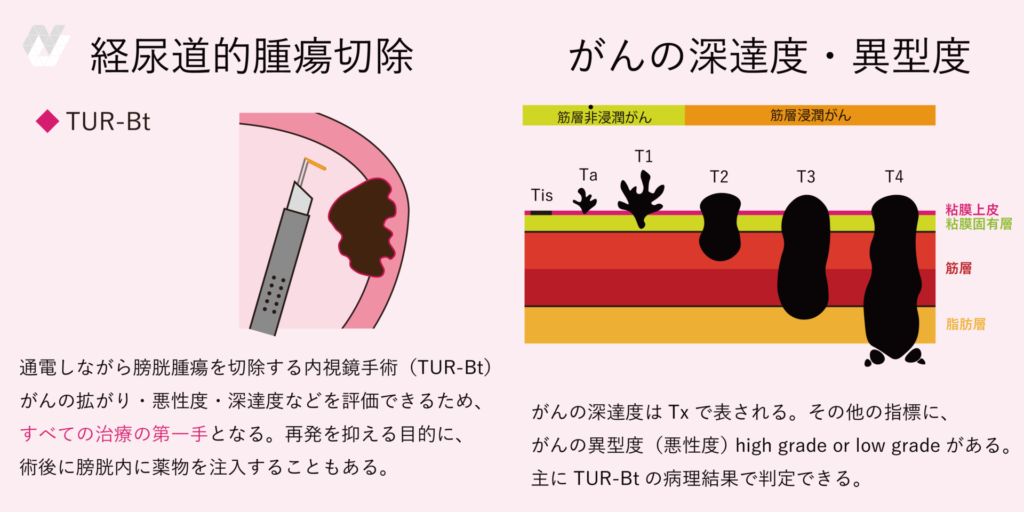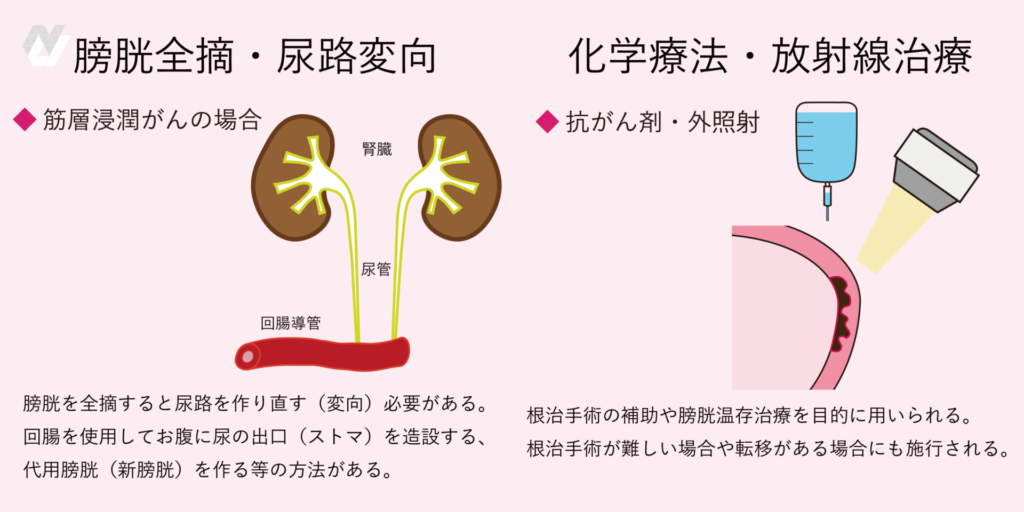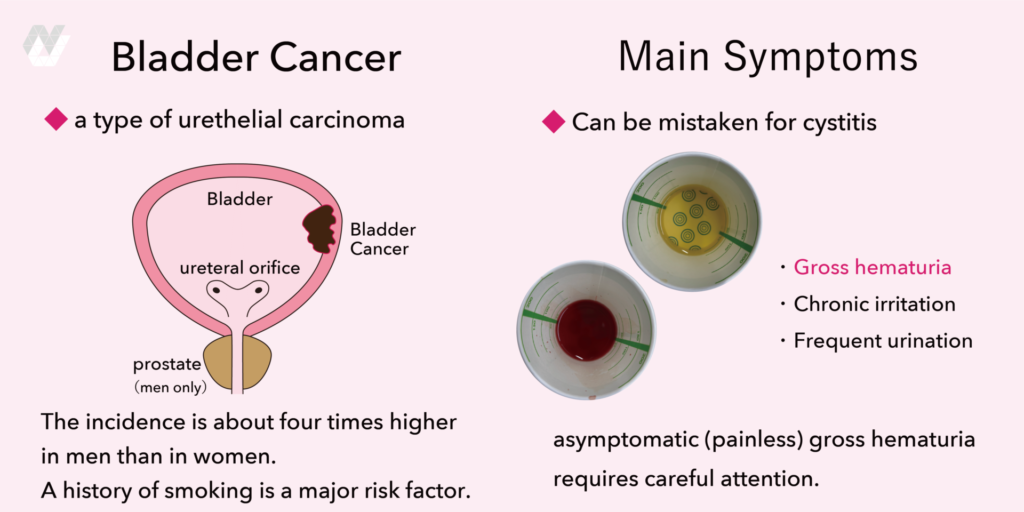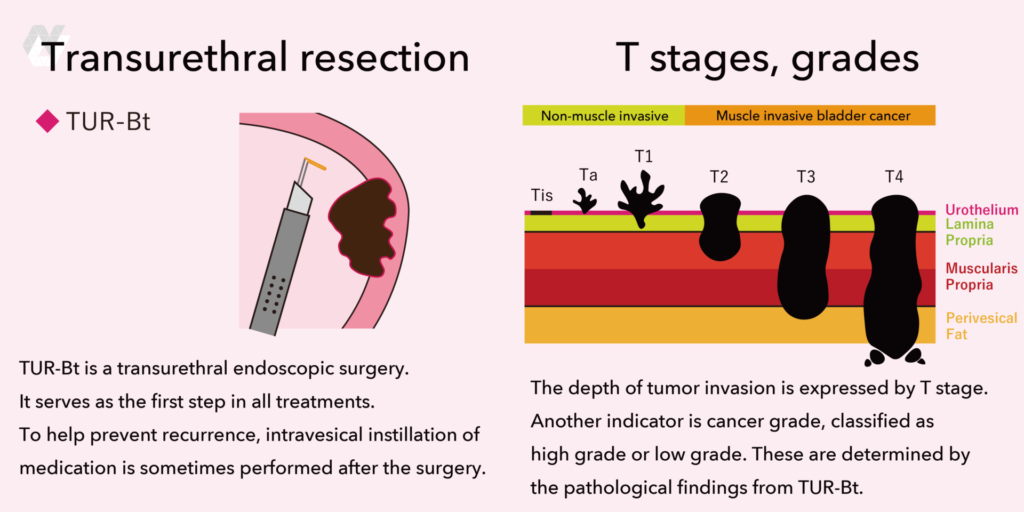
| 月 | 火 | 水 | 木 | 金 | 土 | 日/祝 | |
|---|---|---|---|---|---|---|---|
| 9:00~12:30 |
|
|
|
|
|
~13:00 |
|
| 14:00~17:00 |
|
|
|
|
|
|
|

Please scroll down for the explanation in English.
◆ 膀胱がんとは
膀胱がんは、尿をためる袋である「膀胱」の内側にできるがんで、特に高齢の男性に多く見られます。発生頻度は、男性の方が女性よりもおよそ4倍高いとされています。初期には自覚症状に乏しいことが多いですが、最も代表的なサインは血尿です。

◆ 主な症状
膀胱がんの代表的な症状には以下のようなものがあります。
- 血尿(目に見える肉眼的血尿、または尿検査で指摘される顕微鏡的血尿)
- 排尿時の違和感(痛み・残尿感)
- 頻尿、尿意切迫感(トイレが近い・我慢できない感じ)
これらの症状の一部は、膀胱炎などの尿路感染症や前立腺肥大症・過活動膀胱でも見られるため、泌尿器科による鑑別が大切です。顕微鏡的血尿の場合、尿路悪性腫瘍の有病率は0.2~5.2%とされ、報告によってばらつきがあります(血尿診断ガイドライン2023)。一方で、排尿痛や急な頻尿など膀胱炎のような症状を欠いた血尿(無症候性肉眼的血尿)は特にリスクが高く、悪性腫瘍の可能性を前提とした精査が必要です。
◆ 原因
膀胱がんの原因として以下が知られています。
- 喫煙(タバコ):最も重要な危険因子
- 職業性曝露:染料・ゴム・石油製品などの化学物質(ベンゼン化合物や芳香族アミン)を扱う職業
- 慢性的な膀胱炎や尿道カテーテル(人工物)の留置
- 骨盤臓器への放射線照射の既往
- シクロホスファミドまたはイホスファミドを用いた化学療法歴
ただし、これらに当てはまらないからといって安心できるわけではありません。傾向として、男性および高齢の方の罹患率が高くなります。

◆ 診断と検査
膀胱がんが疑われる場合、以下のような検査を行います。
- 尿検査・尿細胞診
細胞診は尿中にがん細胞が含まれていないかを調べます。簡便ですが、結果を鵜呑みにできるわけではなく、万能ではありません。また、前立腺がんにおけるPSAのような血液で判定できる腫瘍マーカーは膀胱がんには存在しません。 - 画像検査(エコー、CT、MRIなど)
膀胱や尿路の形態や腫瘍の有無を確認します。超音波検査は簡便ですが、小さな病変の同定は困難です。主にCTでは上部尿路(腎・尿管)の異常や転移の有無を調べ、MRIでは膀胱局所の評価を行います。 - 膀胱鏡検査(内視鏡)
膀胱内をカメラで直接観察します。診断に最も重要な検査です。ゼリー状の麻酔薬を尿道内に注入して行います(注射ではないので痛みは強くありません)。麻酔を含めても5〜10分程度で終了する検査で、食事制限などの事前準備も不要です。
◆ 治療法
膀胱がんの治療は、がんの深達度(筋層への浸潤の有無)や悪性度、またその拡がりによって大きく異なります。代表的な治療法をまとめます。
|
種類 |
内容 |
|
経尿道的膀胱腫瘍切除術(TUR-Bt) |
尿道から内視鏡を挿入し、腫瘍を切除する。ほぼすべての膀胱腫瘍で第一選択となる。最近では、腫瘍を細断せずに一塊で摘出する術式(En-bloc TUR)も用いられる。TUR-Btの病理結果によって、がんの深達度や異型度(悪性度)が判定される。 |
|
膀胱内注入療法 |
手術後に膀胱内に抗がん剤を注入し、再発を抑える。再発リスクが高い場合にはBCGを定期的に注入する。 |
|
膀胱全摘+尿路変向(へんこう) |
がんが筋層に及んでいる場合(筋層浸潤がん)に行う根治手術。膀胱を摘出するため、尿路再建が必要になる。腸管(回腸)を一部利用し、お腹に尿の出口(ストマ)を作る方法(回腸導管)や、代用膀胱を造設する方法がある。現在はロボット支援手術が一般的。 |
|
化学療法・放射線療法 |
根治手術の補助や膀胱温存治療を目的に行う。根治手術が難しい場合や転移がある場合にも施行される。 |


◆ 最後に
膀胱がんは、早期発見・早期治療によって十分に治療可能ながんです。
「目で見てわかる血尿が出た」「尿潜血を繰り返し指摘される」「膀胱炎が治りにくい」などの症状があれば、たとえ一時的な症状でも放置せず、泌尿器科でのチェックをおすすめします。定期健診で異常を指摘された場合も、お気軽にご相談ください
この記事は、西川口泌尿器科クリニック院長 内田裕將(日本専門医機構認定 泌尿器科専門医)により執筆されています。
◆ What is bladder cancer?
Bladder cancer is a type of cancer that develops on the inner lining of the bladder, the organ that stores urine. It is most commonly seen in older men, with men being about four times more likely to develop it than women. In the early stages, there are often few noticeable symptoms, but the most typical sign is blood in the urine (hematuria).

◆ Main Symptoms
Typical symptoms of bladder cancer include:
- Hematuria (visible blood in the urine, or microscopic hematuria detected by urine tests)
- Discomfort during urination (pain or a feeling of incomplete emptying)
- Frequent urination or urgency (needing to go often or being unable to hold urine)
Some of these symptoms can also occur with urinary tract infections (such as cystitis), benign prostatic hyperplasia, or overactive bladder, so it is important to have them evaluated by a urologist. For microscopic hematuria, the reported prevalence of urinary tract malignancies ranges from 0.2–5.2% (Guidelines for Diagnosis of Hematuria 2023). On the other hand, asymptomatic gross hematuria (hematuria without symptoms such as pain or frequent urination) carries a particularly high risk and requires careful evaluation for possible malignancy.
◆ Causes
Known risk factors for bladder cancer include:
- Smoking: the most significant risk factor
- Occupational exposure: working with chemicals such as dyes, rubber, petroleum products, benzene compounds, and aromatic amines
- Chronic bladder inflammation or long-term indwelling urinary catheters
- Previous radiation therapy to the pelvic organs
- Prior chemotherapy with cyclophosphamide or ifosfamide
However, not having these risk factors does not mean one is safe. Overall, the risk is higher among men and older individuals.

◆ Diagnosis and Tests
If bladder cancer is suspected, the following tests may be performed:
- Urine test and urine cytology
Cytology examines urine for the presence of cancer cells. While convenient, it is not completely reliable. Unlike prostate cancer (which has a blood marker called PSA), there is no blood-based tumor marker for bladder cancer. - Imaging tests (ultrasound, CT, MRI)
These evaluate the bladder and urinary tract for abnormalities or tumors. Ultrasound is convenient but less effective for detecting small lesions. CT is mainly used to assess the upper urinary tract (kidneys and ureters) and to check for metastasis, while MRI is helpful for evaluating the local extent of bladder cancer. - Cystoscopy (endoscopy of the bladder)
A small camera is inserted through the urethra to directly observe the inside of the bladder. This is the most important diagnostic test. It is performed under local anesthesia using a gel, not an injection, and usually takes only 5–10 minutes. No dietary restrictions or special preparation are needed beforehand.
◆ Treatments
Treatment for bladder cancer varies depending on how deeply the cancer has invaded the bladder wall (muscle invasion), its grade (malignancy), and how far it has spread. Common treatments include:
|
Treatment |
Description |
|
Transurethral resection of bladder tumor (TUR-Bt) |
A procedure performed through the urethra to remove the tumor with an endoscope. This is the first-line treatment for almost all bladder tumors. Recently, the en-bloc TUR technique, which removes the tumor in one piece instead of fragmenting it, has also been used. The pathology from TUR-Bt determines the depth of invasion and tumor grade. |
|
Intravesical therapy |
After surgery, anti-cancer drugs are instilled directly into the bladder to reduce the risk of recurrence. For high-risk cases, intravesical BCG (Bacillus Calmette–Guérin) therapy is administered on a regular schedule. |
|
Radical cystectomy with urinary diversion |
Performed when the cancer has invaded the bladder muscle (muscle-invasive bladder cancer). Since the bladder is removed, the urinary tract must be reconstructed. This may involve creating a stoma using a segment of the intestine (ileal conduit) or constructing a neobladder. Nowadays, robotic-assisted surgery is commonly performed. |
|
Chemotherapy and radiotherapy |
Used as additional treatment to surgery, as part of bladder-preserving therapy, or in cases where surgery is not possible or when metastases are present. |


◆ In Conclusion
Bladder cancer can often be treated successfully if detected early. If you notice visible blood in your urine, are repeatedly told you have microscopic hematuria, or experience persistent cystitis-like symptoms that do not improve, do not ignore these signs—even if they seem temporary. Please visit a urologist for evaluation. Likewise, if an abnormality is found during a health checkup, feel free to consult us.
This article was written by
Director, Nishikawaguchi Urology Clinic
Board-Certified Urologist (certified by the Japanese Medical Specialty Board)
